The High Court yesterday acquitted five defendants in the 2013 Advanced Semiconductor Engineering Inc (ASE) pollution case, contrary to public expectations of environmental protection and social justice, Green Party Taiwan co-convener Lee Ken-cheng (李根政) said, adding that it was an example of the judicial system’s tendency to protect business groups.
The court said in its ruling that the few pollution records provided by the Kaohsiung City Government were not enough to determine the defendants’ guilt, Lee said, adding that the judicial system should recognize the difficulties environmental agencies face in ascertaining that pollution regulations have been breached, as even a single record showing irregularity is difficult to gather.
Existing regulations cannot effectively curb pollution because of lenient and delayed punishments, Lee said, calling for cooperation between judicial and environmental agencies to establish a pollution database to facilitate a speedy response and disciplinary mechanism where problems are uncovered.
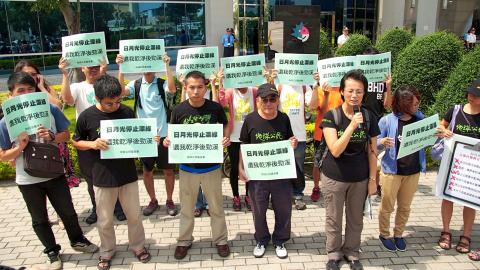
Photo: Hung Ting-hung, Taipei Times
Environmentalist and lawyer Thomas Chan (詹順貴) said the ruling was understandable, because the time gap in the evidence provided by the city government — samples taken from the Houjin River (後勁溪) and an ASE complex in October 2013, as well as samples taken from nearby fishing ponds about 70 days later — was too big to incriminate the defendants.
The city, rather than the judicial system, was to blame, as the city government could have established more pollution testing facilities, as well as a more thorough inspection mechanism if it was determined to curb pollution, Chan said.
The city government’s decision to allow the ASE plant to resume operations was opaque and invited suspicion over whether it really intended to discipline the company.
Separately, Kaohsiung Deputy Mayor Derek Chen (陳金德) said that although ASE saw no judicial punishment in the second ruling, it does not mean the company is without responsibility.
“I hope all businesses shoulder their social responsibility to obey the law and mend their ways after wrongdoing,” Chen said.
“No matter whether it is the Water Pollution Control Act (水污染防治法) or the Waste Disposal Act (廢棄物清理法), it has always been difficult to gather evidence for a prosecution’s case, resulting in only light punishment in the past,” he said, adding that previously the maximum fine allowed by the water pollution act was NT$600,000 (US$18,022), but following an amendment was raised to NT$20 million.
“This case should prompt companies to show more concern and better protect land, rivers and water resources,” Chen said. “I hope they can take up their responsibility and put more resources into pollution control and prevention.”
Chen said that the city government in 2013 fined ASE NT$100 million over improper business proceeds according to the Administrative Penalty Act (行政罰法), but the company filed for administrative litigation and a decision on the case is pending.
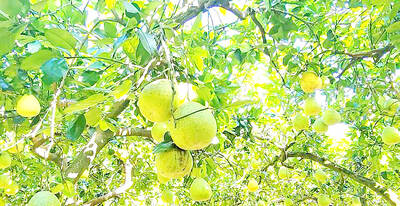
NEW AGREEMENT: Malaysia approved imports last year after nearly two years of negotiations and inspections to meet quarantine requirements, officials said Up to 3.6 tonnes of pomeloes from Taiwan cleared Malaysian customs on Friday, in the first shipment of Taiwanese pomeloes to Malaysia. Taiwan-grown pomeloes are popular in domestic and overseas markets for their tender and juicy taste, the Ministry of Agriculture’s Animal and Plant Health Inspection Agency said. The fruit is already exported to Japan, Canada, Hong Kong, Singapore and the Philippines, it added. The agency began applying for access to the Malaysian market in 2023, compiling data on climate suitability, pests and diseases, and post-harvest handling, while also engaging in nearly two years of negotiations with Malaysian authorities and submitting supplementary
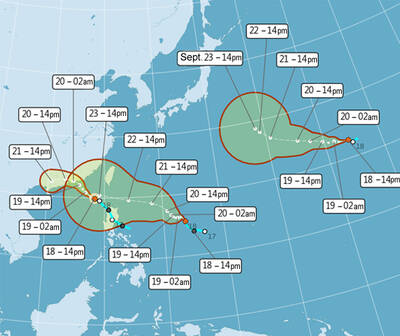
PEAK MONTHS: Data showed that on average 25 to 27 typhoons formed in the Pacific and South China seas annually, with about four forming per month in July and October One of three tropical depressions in the Pacific strengthened into a typhoon yesterday afternoon, while two others are expected to become typhoons by today, Central Weather Administration (CWA) forecaster Lee Ming-hsiang (李名翔) said yesterday. The outer circulation of Tropical Depression No. 20, now Typhoon Mitag, has brought light rain to Hualien, Taitung and areas in the south, Lee said, adding that as of 2pm yesterday, Mitag was moving west-northwest at 16kph, but is not expected to directly affect Taiwan. It was possible that Tropical Depression No. 21 would become a typhoon as soon as last night, he said. It was moving in a
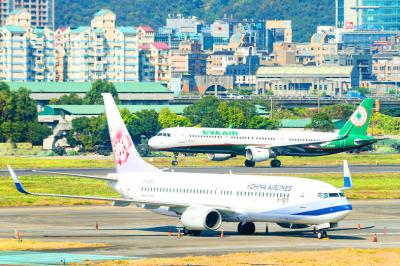
Tigerair Taiwan and China Airlines (CAL) today announced that several international flights were canceled or rescheduled due to Typhoon Ragasa. The Central Weather Administration (CWA) has maintained sea and land warnings for the typhoon. Its storm circle reached the Hengchun Peninsula (恆春半島) on Taiwan's southern tip at 11am today. Tigerair Taiwan said it canceled Monday's IT551/IT552 Taoyuan-Da Nang, IT606/IT607 Taoyuan-Busan and IT602 Taoyuan-Seoul Incheon flights. Tomorrow, cancelations include IT603 Seoul Incheon-Taoyuan, as well as flights between Taoyuan and Sapporo, Osaka, Tokyo Narita, Okinawa, Fukuoka, Saga, Tokyo Haneda, Nagoya, Asahikawa and Jeju. On Wednesday, the IT321/IT322 Kaohsiung-Macau round-trip would also be canceled. CAL announced that today's
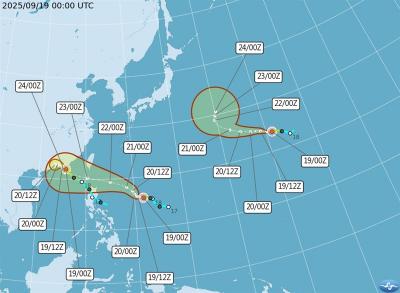
Three tropical depressions yesterday intensified into tropical storms, with one likely to affect Taiwan as a typhoon, the Central Weather Administration (CWA) said. The three storms, named Mitag, Ragasa and Neoguri, were designated as storms No. 17 to 19 for this year, the CWA said. Projected routes indicate that Ragasa is most likely to affect Taiwan, it said. As of 2am today, Ragasa was 1,370km east-southeast of Oluanpi (鵝鑾鼻) on the southernmost tip of Taiwan. It was moving west-northwest before turning northwest, slowing from 11kph to 6kph, the agency said. A sea warning for Ragasa is unlikely before Sunday afternoon, but its outer rim